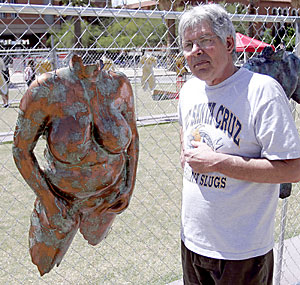 |
|
JOSH FIELDS/Arizona Daily Wildcat
|
Artist Larry Kirkwood presents his sculptures of cast men and women on the UA Mall yesterday afternoon. The exhibit, sponsored by the ASUA's Women's Resource Center, will also be displayed tomorrow on the Mall from 11 a.m. to 2 p.m.
|
|
|
By Alexis Blue
Arizona Daily Wildcat
Wednesday, April 13, 2005
Print this
Tall, curvy, short, thin, round, narrow, muscular and lean – the human body in its many shapes and forms is on display on the UA Mall to reveal the naked truth about body image.
The plaster casts of 20 male and female bodies, taken from volunteers across the country, are the work of Kansas City, Mo., artist Larry Kirkwood, who will lecture this afternoon about the sculptures in his collection and on body image issues and notions of beauty in society.
"There are a lot of people that are just hurting out there," Kirkwood said. "People don't know how to look at themselves."
Kirkwood said unrealistic messages in advertising about what is "beautiful" lead not only to self-image problems in men and women but also to social inequalities and prejudices in everyday life.
"We're judging people on the wrong things," he said.
Since Kirkwood began making plaster casts of people in 1993, his work has been displayed at more than 60 universities, museums and other venues nationwide.
His main message to viewers of his work: "I just want people to stop judging each other on really stupid things that don't matter."
It's a message Ela Cudilo, director of the Women's Resource Center, which is hosting the exhibit and lecture, thinks students need to hear.
"UA students strive for sort of a cookie-cutter body image," Cudilo said. "It's good for the campus to see that there are other body types out there."
Kirkwood said while the sculptures in his collection represent people of varying ages between 15 and 77, he especially likes to show and talk about his work with college-aged students because he wants to educate the "next decision-makers."
Taryn Stockfisch, a pre-education sophomore, said she thinks college students in particular feel a lot of pressure to fit stereotypical ideas of what is beautiful.
"It's something that needs to be brought up more, especially on a college campus where there's all this pressure to be thin and pretty and blonde," Stockfisch said. "This is the perfect place to show this."
Stockfisch said since breast cancer runs in her family, she was especially struck by the cast of a woman who had only one breast, as a result of a mastectomy.
Stockfisch said her aunt had a double mastectomy but still buys padded bras to make it look like she has breasts, and Stockfisch doesn't think women should feel pressured to do that.
"Breasts don't make you a woman," she said.
Cristobal Barajas, a psychology freshman, said he likes how the exhibit features both men and women.
"I'm glad there's both so there's recognition that it's a universal situation," Barajas said. "I like the fact that it's geared toward acceptance and enjoying what you are born with."
While Kirkwood said initial reactions to the exhibit during its first day yesterday were mostly positive, the display has sparked controversy in the past, and the nude sculptures have been banned from some colleges.
"It's censored a lot because people can only see the sexuality," Kirkwood said.
Others object to the project based on personal beliefs, and Kirkwood said he was approached yesterday by a male Islamic student who disapproved of the nude depictions of the female body.
Cudilo said while some viewers might be uncomfortable with the nude representations, it is important to acknowledge their message.
"People have to realize that it's a work of art," Cudilo said. "We're trying to spread (the idea) that all bodies are beautiful."
While only 20 sculptures are on display on campus, Kirkwood has completed more than 500 figures of people of all different races and ethnicities, including casts of anorexic men and women, pregnant women, and individuals whose bodies have been altered by surgeries.
While the casts have only included men and women so far, Kirkwood said he hopes to take casts of individuals who have both male and female anatomies in the future.
Cudilo said she hopes viewing the sculptures will ultimately be "therapeutic" for members of the campus community.
"We're hoping that people looking at the sculptures will say, 'Wow, that's really beautiful,' and that they'll be able to love their own bodies more," Cudilo said.
